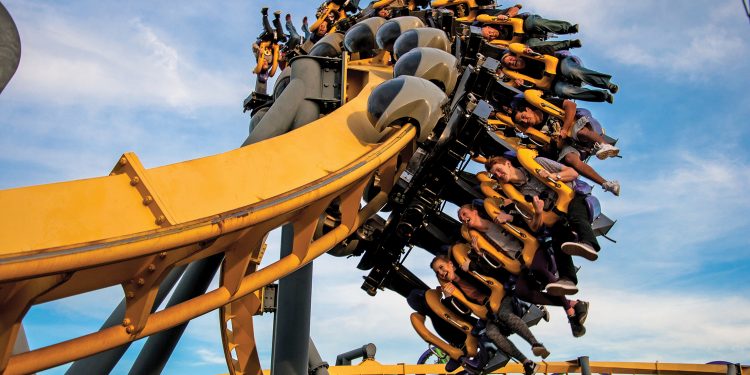The first time I rode a roller coaster, around age 10, at a modest amusement park just outside Chicago, the tracks were, at best, five feet off the ground, it didn’t loop or go upside down or have sharp turns or deep dives. It was bumpy and rickety and noisy and short in duration. By the time we exited I was ready for more.
While the technology of amusement park thrill rides at larger behemoths like Six Flags Over Texas graduated to bloodcurdling and downright foolish, I was still game, until I got older and more petrified and less foolish, which eventually pushed me out of the thrill-seeking demographic.
When I learned recently that Six Flags was turning 60, I thought of taking a ceremonial ride on the Texas SkyScreamer or the Titan, which stands more than 225 feet and can reach speeds of 85 miles per hour. The plan was to do it as a sort of a toast, yet 30 seconds into this notion I came to my senses.
I can barely climb a six-foot ladder these days without feeling woozy. My son no longer snickers when being summoned to blow the leaves off my roof. It is what it is, he now says.
During a visit to the USS Lexington that sits in Corpus Christi Bay, I was cool climbing steep ladders into confined spaces and dimly lit compartments armed only with a small flashlight, but once we headed out onto this long strip off the deck, high above the water, well, my knees went loopy.
I’d always experienced motion sickness, but it has become far more pronounced with age. So, young bloods, it’s not that we don’t want to hit the Titan – we literally can’t, as the brain’s equilibrium (the inner ear) loses its ability to make sense of the motion it is experiencing. The result; nausea, dizziness, anxiety that you really are going to perish.
It is why park staff are trained to keep an eye on older riders, looking for those facial signs of distress.
The last time I ventured inside the Six Flags park, during the annual AISD day, how content I was watching others go up, down, around. I remember catching the eye of another dad my age. We grinned at one another, not saying a word, but knowing precisely why we were both where we were.
Whenever I speak with park officials, they often remind me how speed and conquering one’s fear are actually positive effects. Psychologists describe it as “physiological arousal”; indeed, when I ventured over to the park one Saturday, 23-year-old Vincente Diaz described it as a legal means of “experiencing a natural high.”
Angela Scott said it was a mixture of stress and pleasure, like skydiving.
Another park goer I spoke with compared thrill rides to watching a horror movie, though why you’d want the same visceral sensation in the middle of a ride you can’t escape is beyond me. (At least with the horror flick you have the remote).
If you view the history of Six Flags you can see how the rides have become bigger and faster and scarier.
Of course, Six Flags is more than that. It’s a great place for family time and friend time and fun time.
For its 60th Anniversary, for instance, Six Flags started the year with the Fire & Ice Winter Festival, went into its Spring Break Celebration and is now building up to a new festival, ¡Viva La Fiesta!, which began last month. Nothing scary about that.
But now that I have a granddaughter, my much better half insists this is our opportunity to experience places like Six Flags through her.
I agree, which is why I’m making reservations as we speak for the Fort Worth Zoo.
Can’t get enough of Six Flags Over Texas (especially now that it is celebrating its 60th anniversary)? Check out the Finish Line on page 66, as Richard Greene shares how the park helped a number of notable locals meet and/or bond over the years.
















